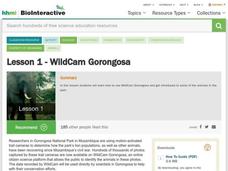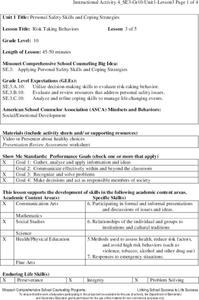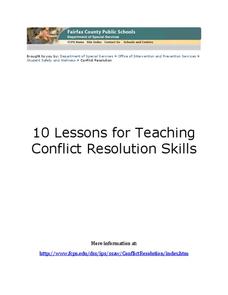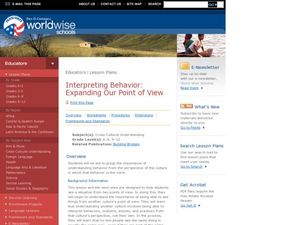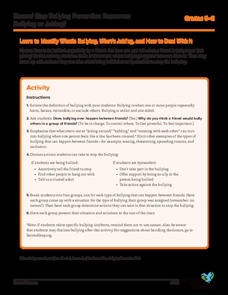Brain Parade
See.Touch.Learn.
Here is a great app that has tons of potential in helping your child or student with severe to moderate autism, or other intellectual disability, learn words and concepts using research-based methods. Children with autism or PDD NOS have...
Health Smart Virginia
Social Emotional Skills Lessons Overview
Sometimes the hardest part of planning any unit of instruction is determining the activities that reinforce the concepts of the lessons and support the development of student skills. This first resource in the Health Smart series...
Curated OER
Fishy Behavior
Here's a lab that may make you rethink that morning cup of coffee. Biology scholars test the effects of caffeine, alcohol, and nicotine on the behavior of zebrafish through an intriguing experiment. Learners observe fish behavior before...
Howard Hughes Medical Institute
Lesson 1: WildCam Gorongosa
Take a walk on the wild side! Episode one of an eight-part series of interactive lessons regarding Gorongosa National Park invites learners to become a part of the citizen science community. Scholars read a brief overview of the trail...
Curated OER
Exploring Learned and Innate Behavior
Students explore the differences between learned and innate behavior among humans and monkeys. They complete an assignment and read articles about two studies, which used similar test methods to show that infants and monkeys share an...
Overcoming Obstacles
Learning to Be Assertive
After defining passive, aggressive, and assertive, class members role-play different scenarios demonstrating these behaviors. Individuals then identify a weakness they wish to improve and, using what they have learned throughout the...
Virginia Department of Education
Functions: Domain, Range, End Behavior, Increasing or Decreasing
Examine key features of various functions through exploration. A comprehensive lesson has learners describe the domain, range, end behavior and increasing/decreasing intervals of various functions. Function types include linear,...
Missouri Department of Elementary
Risk Taking Behaviors
Sophomores can be sometimes wise and sometimes foolish. The same can be said for their behaviors. After watching a presentation about risk taking behaviors, class members discuss the presentation in small groups, and then complete a...
EngageNY
Grade 9 ELA Module 3, Unit 2, Lesson 5
Once you find and evaluate your sources, it's time to discern the most helpful information. In a research lesson plan based on questions derived from Temple Grandin's Animals in Translation, practice annotation and taking notes.
PBIS World
Behavior Specialist Referral Form
Make sure your school's behavior specialist is well-informed by filling out this form when you refer an individual to him or her. The form provides a checklist of behaviors, an academic checklist, and a list of environmental factors to...
EngageNY
End Behavior of Rational Functions
Connect end behavior to previous learning. Pupils connect finding the end behavior of rational functions to finding end behavior of polynomial functions. The 13th segment in a 23-part unit starts with finding the end behavior or power...
Curated OER
Animal Behavior
Students investigate stimulus-response behavior, learned behavior in animals and innate behavior in animals. In this animal behavior lesson plan, students answer questions about their reactions to a toy cap gun that is fired off in...
Polar Bears International
Taking Action!
Motivate young scientists to stand up and take action with this environmental science instructional activity. To begin, the class works in small groups brainstorming actions that support the conservation of the earth before creating and...
Conflict Resolution Education Connection
10 Lessons for Teaching Conflict Resolution Skills
Promote responsibility and camaraderie with 10 lessons on conflict resolution. Learners define conflict and teach ways to resolve it. Each lesson provides an activity and scenario for role play, and lends itself to discussion among peers...
Curated OER
Genes, Environments, and Behavior 2
Students explore the genetic and environmental factors that interact to produce variation in behavior across a population. They are introduced to the various approaches scientists use to explore this interaction. Students explore how...
King Country
Lesson 26: HIV/AIDS & Other STDs - Day 3: HIV/AIDS
The third lesson in the three-part series on HIV/AIDS and other STDs considers how these diseases are passed, how to protect against them, and risky and safe behaviors. The discussion of condom use and sexual behaviors are explicit.
Curated OER
Interpreting Behavior: Expanding Our Point of View
Students explore perspectives. In this diversity lesson, students examine cultural perspectives and world views as they complete activities that challenge them to compare American norms to norms of other cultures.
National Wildlife Federation
Bird Behavior Hike
Bird behaviors have a distinct purpose. Using a tally sheet, learners observe and record different bird behaviors in nature. They practice their observation skills while learning how birds act and why.
Safe Kids Worldwide
Pedestrian Safety Lesson Plan
Distracted pedestrians? Yes. This lesson on pedestrian safety points out the dangers of texting and posting while walking around traffic. In addition, kids learn about safety resources available for those on foot.
Committee for Children
Learn to Identify What’s Bullying, What’s Joking, and How to Deal With It
A quick lesson takes a look at the differences between bullying and joking. Through whole-class discussion, scholars identify between the two behaviors and brainstorm actions to take to cease bullying behavior. Small groups share with...
California Department of Education
Learning the Skills to Pay the Bills
Is CTE the right choice for me? Introduce the class to career and technical education through an exploratory lesson, fourth in a series of six career readiness activities. After an introductory video, scholars determine possible careers...
Curated OER
Animal Behavior - Why Do Dogs Drool?
Students explore types of studied behavior animals acquire. Using a Smart Board file, students simulate rewarding a studied behavior. To further reinforce studied behaviors, students play "Pavlov's Dog" on an internet website. Students...
Curated OER
A Differentiated Art Lesson Plan Based on the Work of Andy Warhol
While this lesson isn't incredibly extensive, it does provide a base on which one can build a differentiated learning experience. Video, discussion, and visuals are used to assist learners in understanding the elements of art and design...
King Country
Lesson 2: Private & Public
What is the difference between a private and a public place? The focus in this second lesson on family life and sexual health is building an understanding of the difference between the concepts of private and public and the behaviors...





